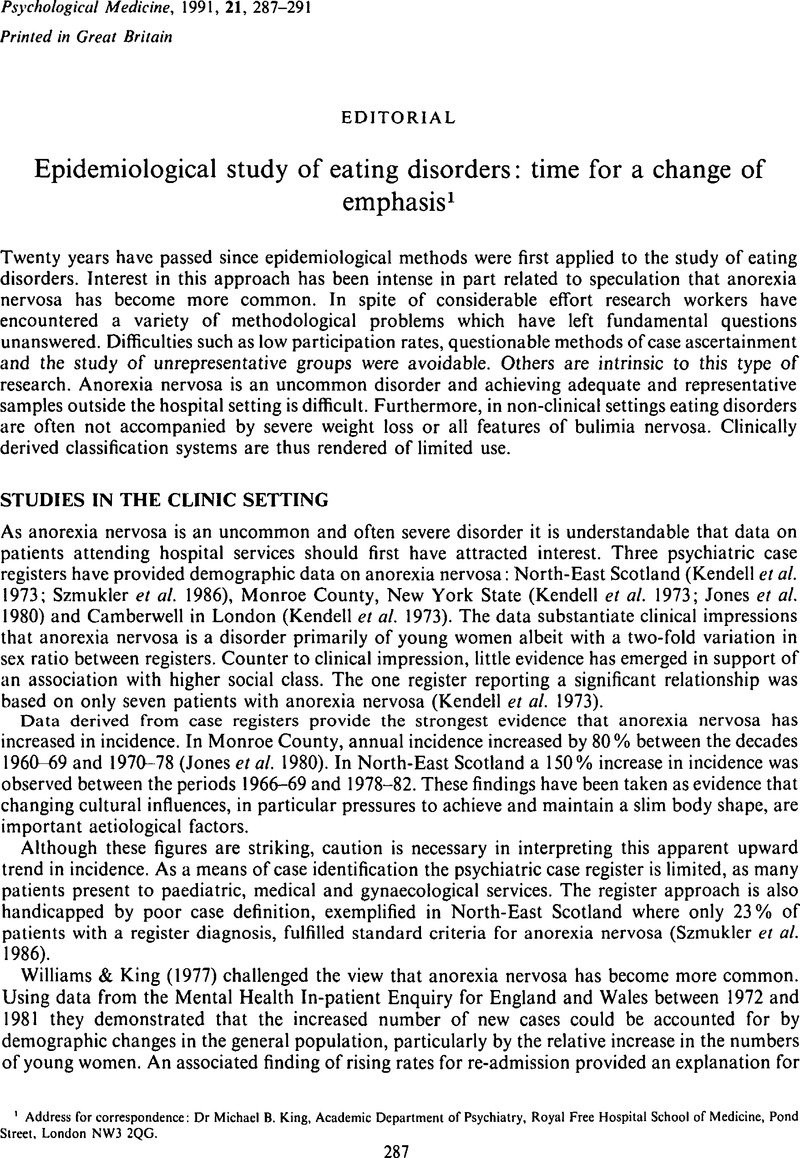Crossref Citations
This article has been cited by the following publications. This list is generated based on data provided by Crossref.
Silverstone, P.H.
1992.
Is chronic low self-esteem the cause of eating disorders?.
Medical Hypotheses,
Vol. 39,
Issue. 4,
p.
311.
Patton, George C.
1992.
Eating Disorders: Antecedents, Evolution and Course.
Annals of Medicine,
Vol. 24,
Issue. 4,
p.
281.
Nasser, M.
1994.
Screening for abnormal eating attitudes in a population of Egyptian secondary school girls.
Social Psychiatry and Psychiatric Epidemiology,
Vol. 29,
Issue. 1,
p.
25.
Råstam, Maria
1994.
Anorexia nervosa: Recent research findings and implications for clinical practice.
European Child & Adolescent Psychiatry,
Vol. 3,
Issue. 3,
p.
197.
Mitrany, Edith
Lubin, Flora
Chetrit, Angela
and
Modan, Baruch
1995.
Eating disorders among Jewish female adolescents in Israel: A 5-year study.
Journal of Adolescent Health,
Vol. 16,
Issue. 6,
p.
454.
Santonastaso, Paolo
Favaro, Angela
Ferrara, Silvia
Sala, Alessandra
and
Zanetti, Tatiana
1995.
Prevalence of body image disturbance in a female adolescent sample: A longitudinal study.
Eating Disorders,
Vol. 3,
Issue. 4,
p.
342.
Munk‐Jørgensen, P.
Møller‐Madsen, S.
Nielsen, S.
and
Nystrup, J.
1995.
Incidence of eating disorders in psychiatric hospitals and wards in Denmark, 1970–1993.
Acta Psychiatrica Scandinavica,
Vol. 92,
Issue. 2,
p.
91.
Wakeling, A.
1996.
Epidemiology of anorexia nervosa.
Psychiatry Research,
Vol. 62,
Issue. 1,
p.
3.
Råstam, M.
and
Gillberg, C.
1996.
Anorexia nervosa rates – conclusions for the wrong reasons.
British Journal of Psychiatry,
Vol. 168,
Issue. 2,
p.
251.
Neumark-Sztainer, D.
Butler, R.
and
Palti, H.
1997.
Persistence of Weight Loss Behavior Among Adolescent Girls in Jerusalem.
International Journal of Adolescent Medicine and Health,
Vol. 9,
Issue. 1,
Lee, Young Ho
Rhee, M. K.
Park, S. H.
Sohn, C. H.
Chung, Y. C.
Hong, S. K.
Lee, B. K.
Chang, P.
Yoon, A. R.
and
Oliosi, M.
1998.
Epidemiology of eating disordered symptoms in the Korean general population using a Korean version of the Eating Attitudes Test.
Eating and Weight Disorders - Studies on Anorexia, Bulimia and Obesity,
Vol. 3,
Issue. 4,
p.
153.
Benedikt, Rachel
Wertheim, Eleanor H.
and
Love, Anthony
1998.
Eating Attitudes and Weight-Loss Attempts in Female Adolescents and Their Mothers.
Journal of Youth and Adolescence,
Vol. 27,
Issue. 1,
p.
43.
Srinivasan, T.N.
Suresh, T.R.
and
Jayaram, Vasantha
1998.
Emergence of Eating Disorders in India. Study of Eating Distress Syndrome and Development of a Screening Questionnaire.
International Journal of Social Psychiatry,
Vol. 44,
Issue. 3,
p.
189.
King, Michael
1998.
The epidemiology of eating disorders.
Epidemiologia e Psichiatria Sociale,
Vol. 7,
Issue. 1,
p.
32.
Mintz, Laurie B.
and
O'Halloran, M. Sean
2000.
The Eating Attitudes Test: Validation With DSM-IV Eating Disorder Criteria.
Journal of Personality Assessment,
Vol. 74,
Issue. 3,
p.
489.
Shinkwin, Rosemary
and
Standen, P. J.
2001.
Trends in anorexia nervosa in Ireland: A register study.
European Eating Disorders Review,
Vol. 9,
Issue. 4,
p.
263.
Rojo, Luis
Livianos, Lorenzo
Conesa, Llanos
García, Angeles
Domínguez, Alberto
Rodrigo, Gloria
Sanjuán, Lluis
and
Vila, Marisa
2003.
Epidemiology and risk factors of eating disorders: A two‐stage epidemiologic study in a Spanish population aged 12–18 years.
International Journal of Eating Disorders,
Vol. 34,
Issue. 3,
p.
281.
Lee, Sing
2004.
Engaging Culture: An Overdue Task for Eating Disorders Research.
Culture, Medicine and Psychiatry,
Vol. 28,
Issue. 4,
p.
617.
Rojo‐Moreno, Luis
Livianos‐Aldana, Lorenzo
Conesa‐Burguet, Llanos
and
Cava, Gloria
2006.
Dysfunctional rearing in community and clinic based populations with eating problems: prevalence and mediating role of psychiatric morbidity.
European Eating Disorders Review,
Vol. 14,
Issue. 1,
p.
32.
Rojo, Luis
Conesa, Llanos
Bermudez, Ovidio
and
Livianos, Lorenzo
2006.
Influence of Stress in the Onset of Eating Disorders: Data From a Two-Stage Epidemiologic Controlled Study.
Psychosomatic Medicine,
Vol. 68,
Issue. 4,
p.
628.



